Investigation and Evaluation of Geothermal Resources in Northern Shanxi Province, China
Abstract
1. Introduction
2. Geological Background
2.1. Geological Setting
2.2. Geothermal Geological Conditions
3. Methodology
3.1. Introduction of Methods
- (1)
- Large exploration depth: In the CSAMT, parameters such as the transmission frequency range and transmission and reception distances can be set according to the geoelectric characteristics of each work area. Compared to the loop-source TEM, when a lower emission frequency is used, the exploration depth increases, reaching up to 2 km or more.
- (2)
- Significant penetration of the high-resistivity shielding layer: This method receives perpendicular electric and magnetic fields simultaneously. The electromagnetic signal is perpendicular to the ground in the receiving area, and the observation and calculation of the electromagnetic component are normalized. Therefore, it can effectively penetrate high-resistivity cap layers on the ground.
- (3)
- Larger transmitting power and strong anti-interference ability: This method adopts an artificially controllable transmitting source with a high transmitting power (up to 30 kW) capable of precise frequency division, excellent stability, and high-order superposition. It can also suppress the interference of ground electricity.
- (4)
- Effective exploration of high-resistivity basement formations: In cases with a significant exploration depth, generally in high-resistivity basement formations, CSAMT uses a lower operating frequency (less than 1 Hz) as the transmitting signal, which exhibits reduced signal attenuation in this frequency band.
3.2. Survey Line Layout
4. Results
4.1. Seismic Exploration
- (1)
- A prominent reflection interface at a depth of approximately 300 m was interpreted as an unconformity between the Quaternary deposits and the Neogene strata (indicated by the light blue line). Another significant reflection interface at a depth of 1600 m was interpreted as an unconformity between the Archean epidermal rocks and Cenozoic sediments (indicated by the dark blue line in Figure 3).
- (2)
- Profiles L1 and L2 show a sudden interruption of the coherency axis representing the Quaternary strata (highlighted by green boxes in Figure 3a,b). This interruption marks the upper boundary point of the Yunmen Fault (F52). Profile L4 exhibited a continuous reflection interface between the coherency axes of the Neogene and adjacent Archean epidermal rock strata (dark blue line), which gradually disappeared toward the middle of the profile (highlighted in the magenta box in Figure 3c). This location represents the lower boundary point of the Yunmen Fault (F52).
- (3)
- An observable disruption in the reflection wave coherency axes (indicated by red lines), which was interpreted as evidence of the Yunmen Fault (F52), appears at the center of each profile.
4.2. CSAMT Exploration
- The study area exhibits typical features of a rift basin.
- The high-resistivity zones at depth on both the left (north) and right (south) sides of the profile correspond to Neoarchean surface rocks (areas enclosed by orange contour lines), whereas the moderate-resistivity zones in the shallow sections are Quaternary cover layers, and the low-resistivity zones in the center are Eocene and Miocene gravel layers, along with altered zones.
- A noticeable resistivity anomaly in the left-central part of the profile was inferred to be the Yunmen Fault (F52) (indicated by the red line), with an inclination angle of approximately 70°.
- In profile L2, the low-resistivity zones S1, S2, and S3 (areas delineated by the cyan blue contour lines) may be due to subsurface fluid activity.
4.3. Borehole Test
5. Discussion
5.1. Heat Source Mechanism and Transfer Method
5.2. Heat Reservoir and Caprock
5.3. Geothermal System Model
6. Conclusions
- (1)
- The stratigraphy of the study area can be divided into three segments from top to bottom: the first segment is the caprock of the geothermal reservoir, comprising Quaternary deposits; the second segment is the thermally altered layer, primarily consisting of Miocene and Eocene gravel; and the third segment is the Archean metamorphic rock geothermal reservoir.
- (2)
- The Yunmenshan Mountain Front Fault Zone and Gushan Village Normal Fault are the primary heat-controlling structures. The direct heat source could be an uncooled magmatic chamber in the middle of the upper crust. Under the influence of extensional tectonic stress, partial melts from the upper mantle ascend along deep, large faults, or structurally weak zones to form magma chambers. The heat released from these uncooled magma chambers and deeper mantle magma reservoirs is transmitted to the shallow surface along fracture zones or through metamorphic rock strata with high thermal conductivity, thereby creating geothermal anomalies.
- (3)
- The high-temperature geothermal system in the northern Shanxi Province exhibits both convective and conductive characteristics. Atmospheric precipitation and low-temperature surface water infiltrate downwards and are heated by geothermal reservoirs. The heated water then ascends along fault zones and spreads beneath the Quaternary caprock, forming a hydrothermal circulation system.
Author Contributions
Funding
Data Availability Statement
Conflicts of Interest
References
- Hill, M.; Dehouche, Z. A comparative analysis of the Effectiveness of aquifer Thermal Energy storage in expeditionary campaign infrastructure. Appl. Therm. Eng. 2017, LI, 114271–114278. [Google Scholar] [CrossRef]
- Liu, Y.; Hou, J.; Zhao, H.; Liu, X.; Xia, Z. A method to recover natural gas hydrates with geothermal energy conveyed by CO2. Energy 2018, 144, 265–278. [Google Scholar] [CrossRef]
- Zhu, J.; Hu, K.; Lu, X.; Huang, X.; Liu, K.; Wu, X. A review of geothermal energy resources, development, and applications in China: Current status and prospects. Energy 2015, 93, 466–483. [Google Scholar] [CrossRef]
- Baikadamova, A.M. The use of geothermal energy using the example of the Zharkent geothermal water deposit. Eng. J. Satbayev. Univ. 2024, 146, 41–46. [Google Scholar] [CrossRef]
- Mnzool, M.; Al-Mukhtar, A.; Majeed, A.J.; Arafat, A.; Gomaa, E. Simulation and performance characteristics of rock with borehole using Visual Finite Element Analysis. Min. Miner. Depos. 2024, 18, 33–41. [Google Scholar] [CrossRef]
- Shi, Y.; Song, X.; Li, J. Numerical investigation on heat extraction performance of AMultilateral-well enhanced geothermal system with A discrete fracture network. Fuel 2019, 244, 207–226. [Google Scholar] [CrossRef]
- Zhang, D.Z.; Ma, Y.Q.; Su, Y.Q. Study on the Calculation of Geothermal Fluids Recoverable Quantity and the Distribution Law of Karst Geothermal Reservoirs in Hebei Plain; Geological Survey of China: Beijing, China, 2018; Volume 5, pp. 78–85. [Google Scholar]
- Dai, M.G.; Lei, H.F.; Hu, J.G.; Guo, X.F.; Ma, P.P.; Zhang, J. Evaluation of recoverable geothermal resources and development parameters of Mesoproterozoic thermal reservoir with the top surface depth of 3500 m and shallow in Xiong’an new area. Acta Geol. Sin. 2019, 93, 2874–2888. [Google Scholar]
- Zhu, X.; Wang, G.; Wang, X.; Qi, S.; Ma, F.; Zhang, W.; Zhang, H. Hydrogeochemical and isotopic analyses of deep geothermal fluids in the Wumishan Formation in Xiong’an new area, China. Lithosphere 2022, 2021, 2576752. [Google Scholar] [CrossRef]
- Pei, F.G.; He, M.X.; Fang, H.; Wang, X.B.; Qiu, G.; Zhang, X.; Lu, Q.; Zhang, Y.; Yuan, Y.; Wang, X. Evaluation of deep geothermal resources potential in the Songliao Basin based on the fuzzy mathematics. Earth Sci. 2023, 48, 1058–1079. [Google Scholar]
- Zhao, J.; Guo, Q.H. Geothermal resources evaluation based on 3D geological modeling: The case of Shidian geothermal area. Earth Sci. 2023, 48, 1107–1117. [Google Scholar]
- Luo, Q.; Li, C.; Ren, G. The late quaternary activity features and slip rate of the Yanggao-Tianzhen fault. Seismol. Geol. 2020, 42, 399–413. [Google Scholar]
- Min, C.; Dong, S.; Wei, S.; Zhou, T.; Chen, L.; Chen, X. Structural analysis on the formation mechanism of Datong Basin. Geol. Rev. 2015, 61, 1235–1247. [Google Scholar]
- Shi, W.; Cen, M.; Chen, L.; Wang, Y.; Chen, X.; Li, J.; Chen, P. Evolution of the Late Cenozoic tectonic stress regime in the Shanxi Rift, central North China Plate inferred from new fault kinematic analysis. J. Asian Earth Sci. 2015, 114, 54–72. [Google Scholar] [CrossRef]
- Song, M.; Yong, Z.; Can, G.E. Relocation of small to moderate earthquakes in Shanxi Province and its relation to the seismogenic structures. Chin. J. Geophys. 2012, 55, 513–525. [Google Scholar]
- He, L.; Guo, Z.; Chen, J.; Yang, Y. Seismic imaging of a magma chamber and melt recharge of the dormant Datong volcanoes. Earth Space Sci. 2021, 8, e2021. [Google Scholar] [CrossRef]
- Dou, S. The relation between Quanternary volcano and earthquake activity in the Datong Basin. Bol. Inst. Crustal Dyn. 1996, 22, 52–58. [Google Scholar]
- Liu, J.; Wang, G.; Jian, X.; Zhu, C.; Hu, X.; Yuan, X.; Wang, C. Tectono-thermal mechanism and hydrocarbon generation action in the north Yellow Sea Eastern Sub-basin. Earth Sci. Front. 2024, 31, 206–218. [Google Scholar]
- Wang, G.L.; Zhang, W.; Liang, J.Y.; Lin, W.J.; Wang, W.L. Evaluation of geothermal resources potential in China. Acta Geosci. Sin. 2017, 38, 449–459. [Google Scholar]
- Sass, J.H.; Lachenbruch, A.H.; Moses, T.H.; Morgan, P. Heat flow from a scientific research well at Cajon Pass, California. J. Geophys. Res. 1992, 97, 5017–5030. [Google Scholar] [CrossRef]
- Yang, Y.; Li, Z.; Wang, H. Experimental study on the influence of ion components in geothermal water on scaling behavior. Energies 2025, 18, 946. [Google Scholar] [CrossRef]
- Li, C.; Luo, J.; Fan, C.; Li, S.; Wu, S.; Lei, C.; Song, K. Impact of high thermal setting and fluid activities on sandstone compaction: A case study of the Baiyun Sag in the Pearl River Mouth Basin (northern South China Sea). Geofluids 2021, 2021, 6658729. [Google Scholar] [CrossRef]
- Gan, H.; Wang, G.; Lin, W.; Wang, X.; Feng, M.; Xi, Z. Research on the occurrence types and genetic models of hot dry rock resources in China. Sci. Technol. Rev. 2015, 33, 22–27. [Google Scholar]
- Lu, C.; Lin, W.; Gan, H.; Liu, F.; Wang, G. Occurrence types and genesis models of hot dry rock resources in China. Environ. Earth Sci. 2017, 76, 646. [Google Scholar] [CrossRef]
- Zhai, M. Cratonization and the Ancient North China Continent: A summary and review. Sci. China Earth Sci. 2011, 54, 1110–1120. [Google Scholar] [CrossRef]
- Zhu, R.; Xu, Y.; Zhu, G.; Zhang, H.; Xia, Q.; Zheng, T. Destruction of the North China craton. Sci. China Earth Sci. 2012, 55, 1565–1587. [Google Scholar] [CrossRef]
- Zhou, W. Electrical Structure of Geothermal Area in Northeast of Datong Basin; China University of Geosciences: Wuhan, China, 2021. [Google Scholar]
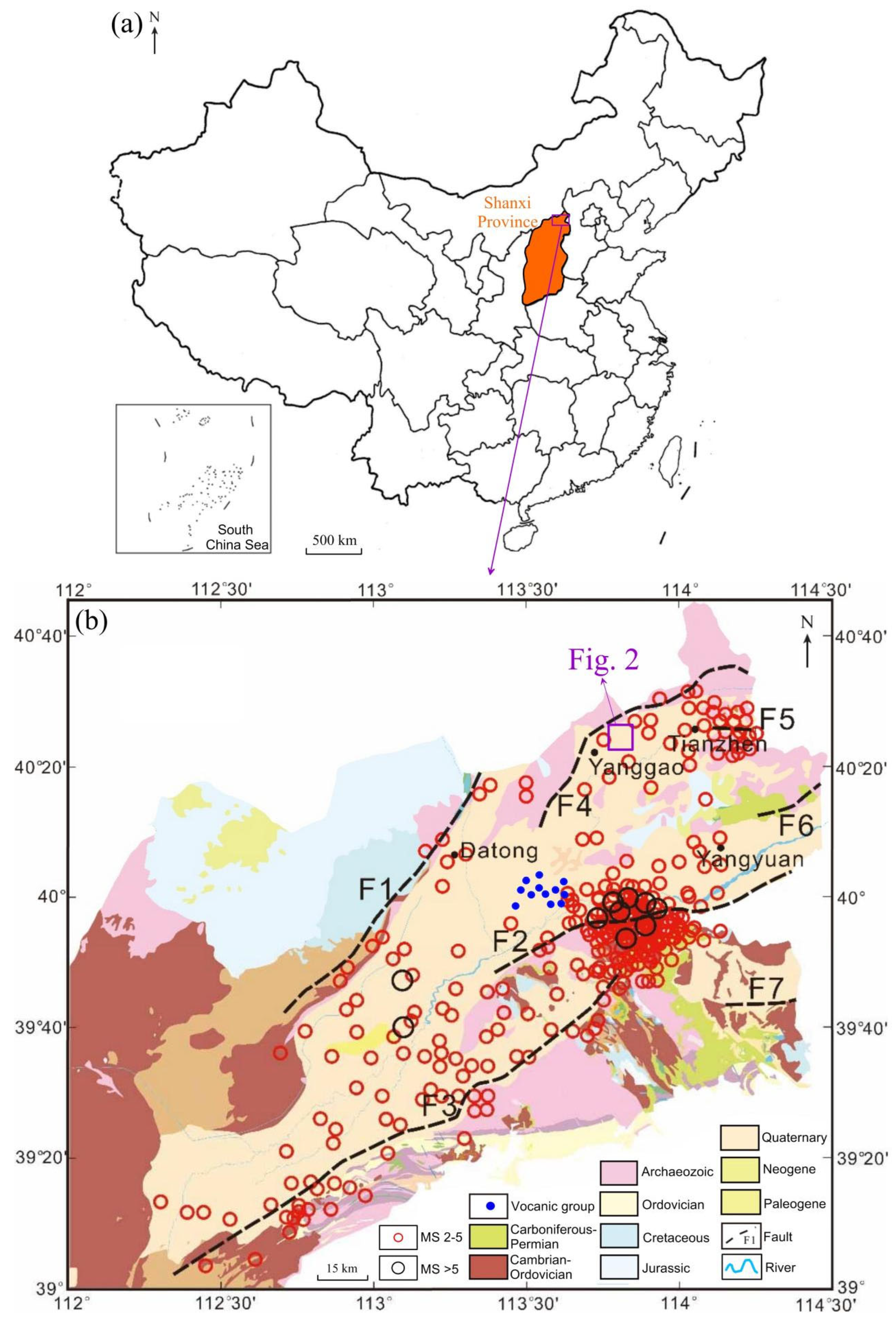
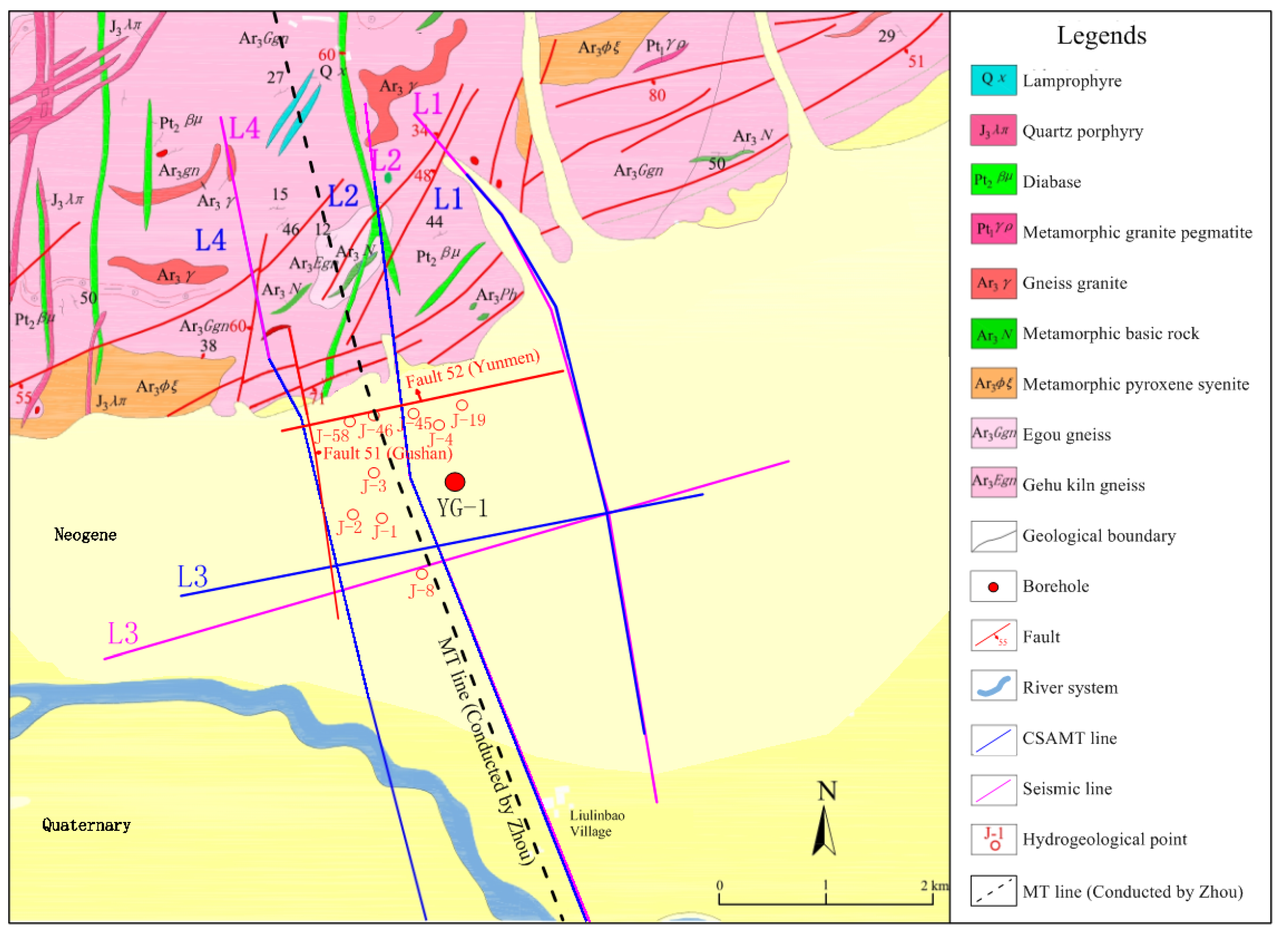
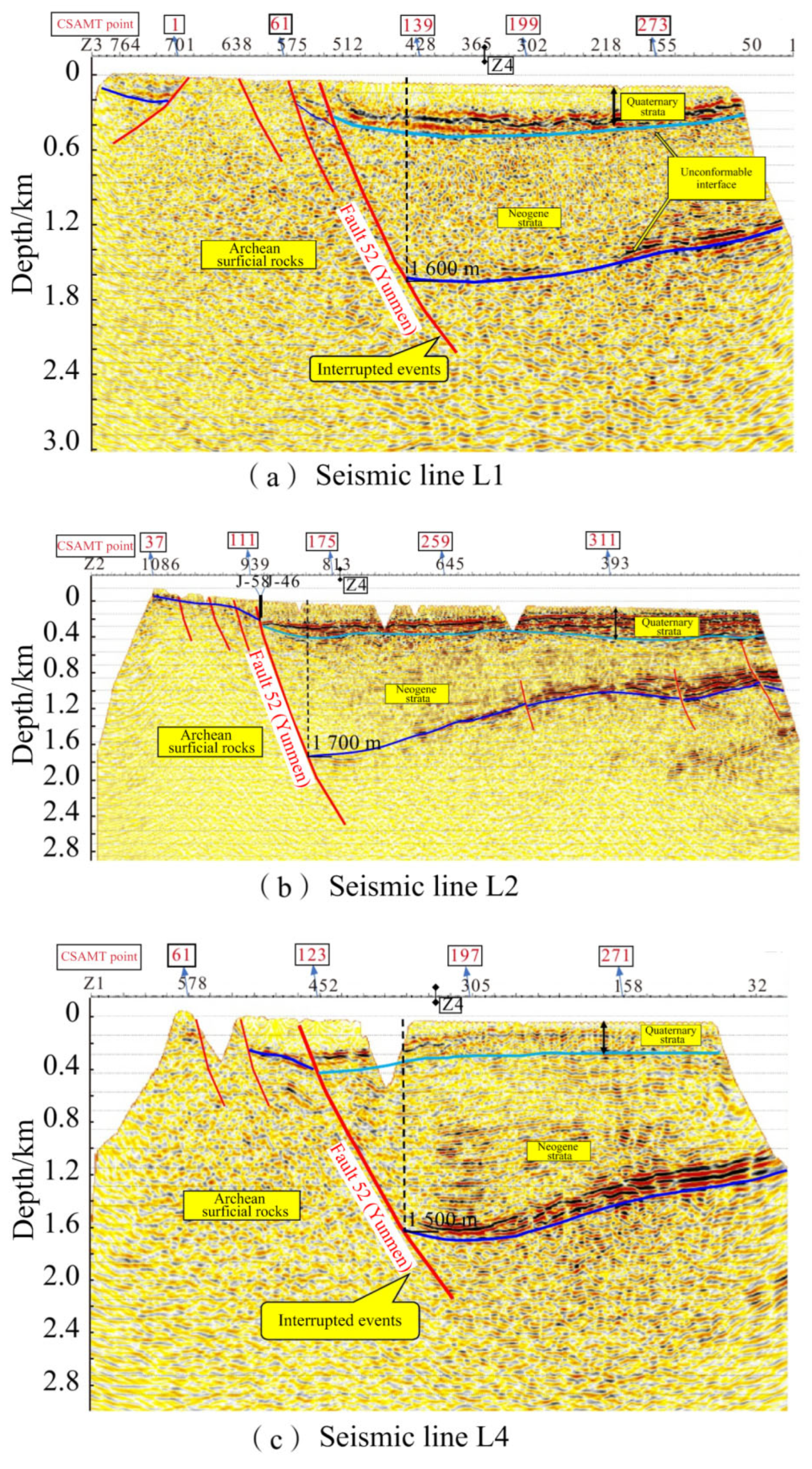
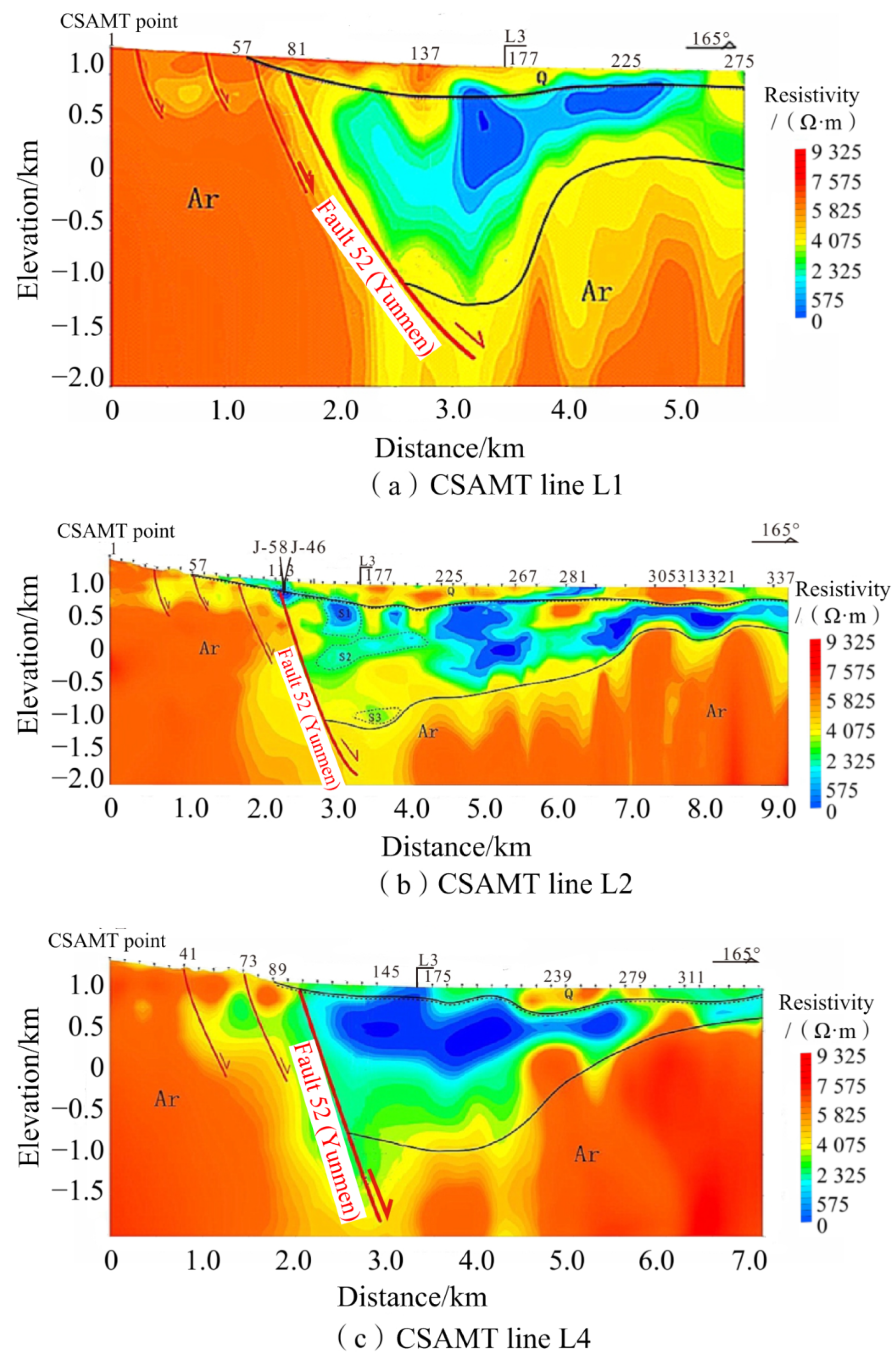
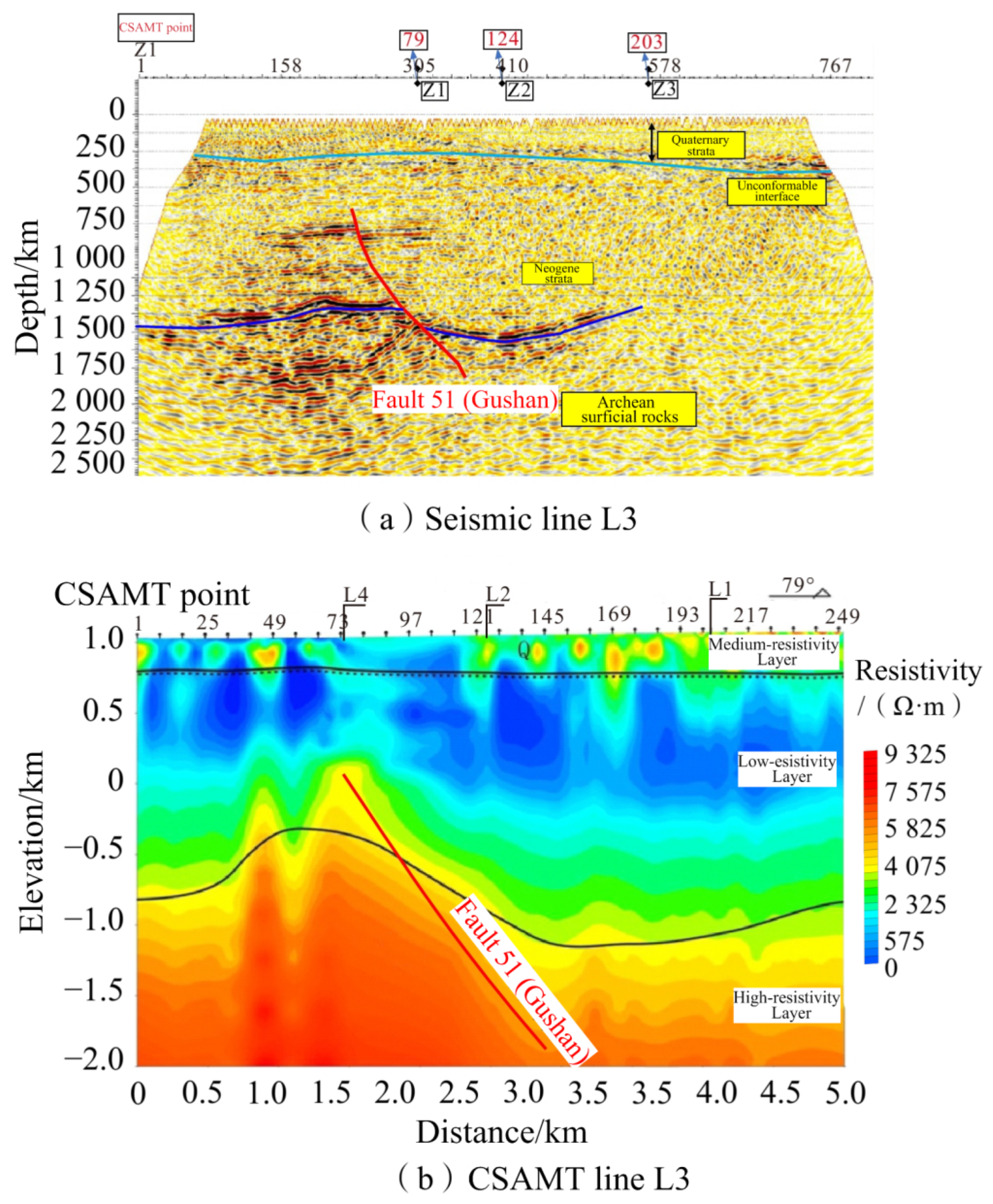
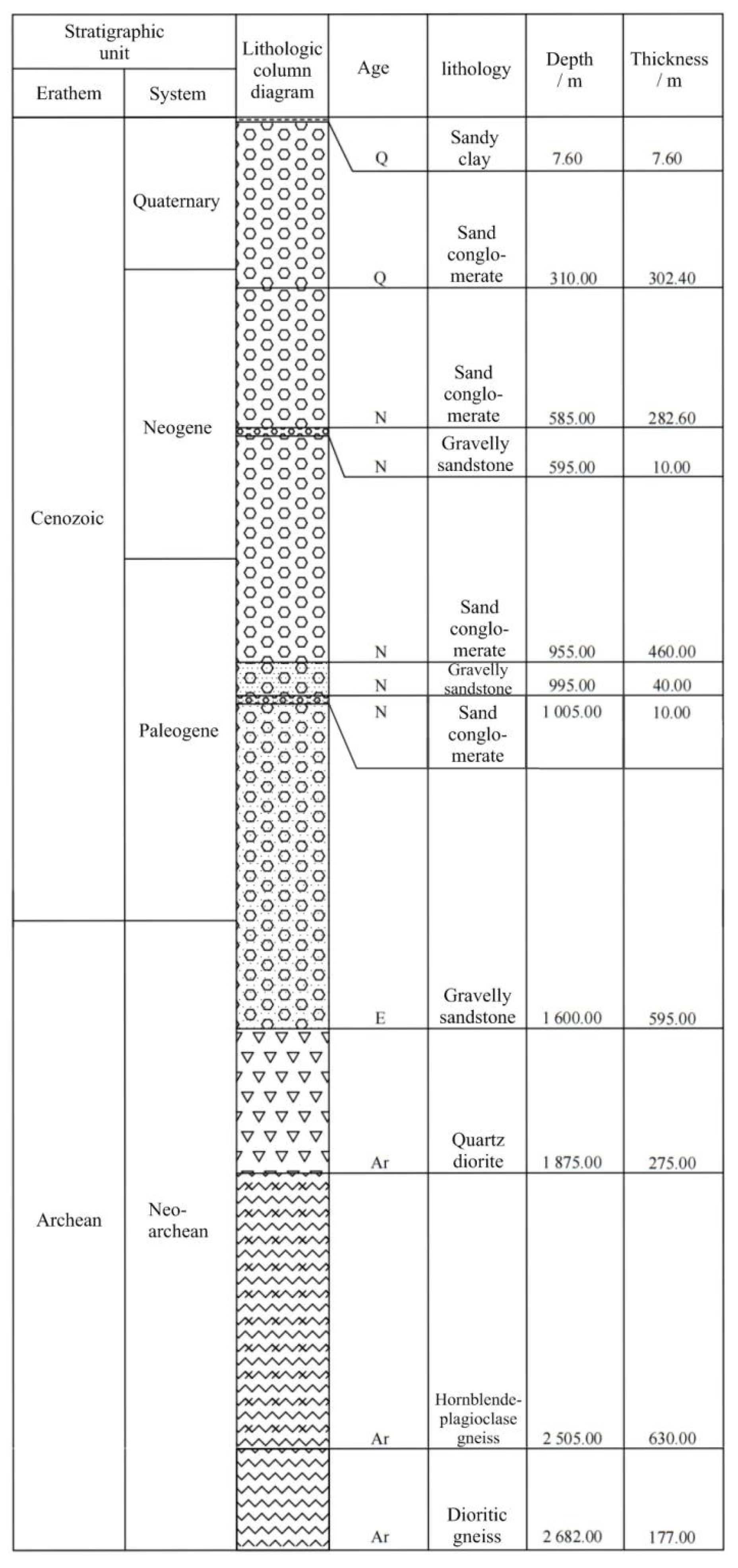

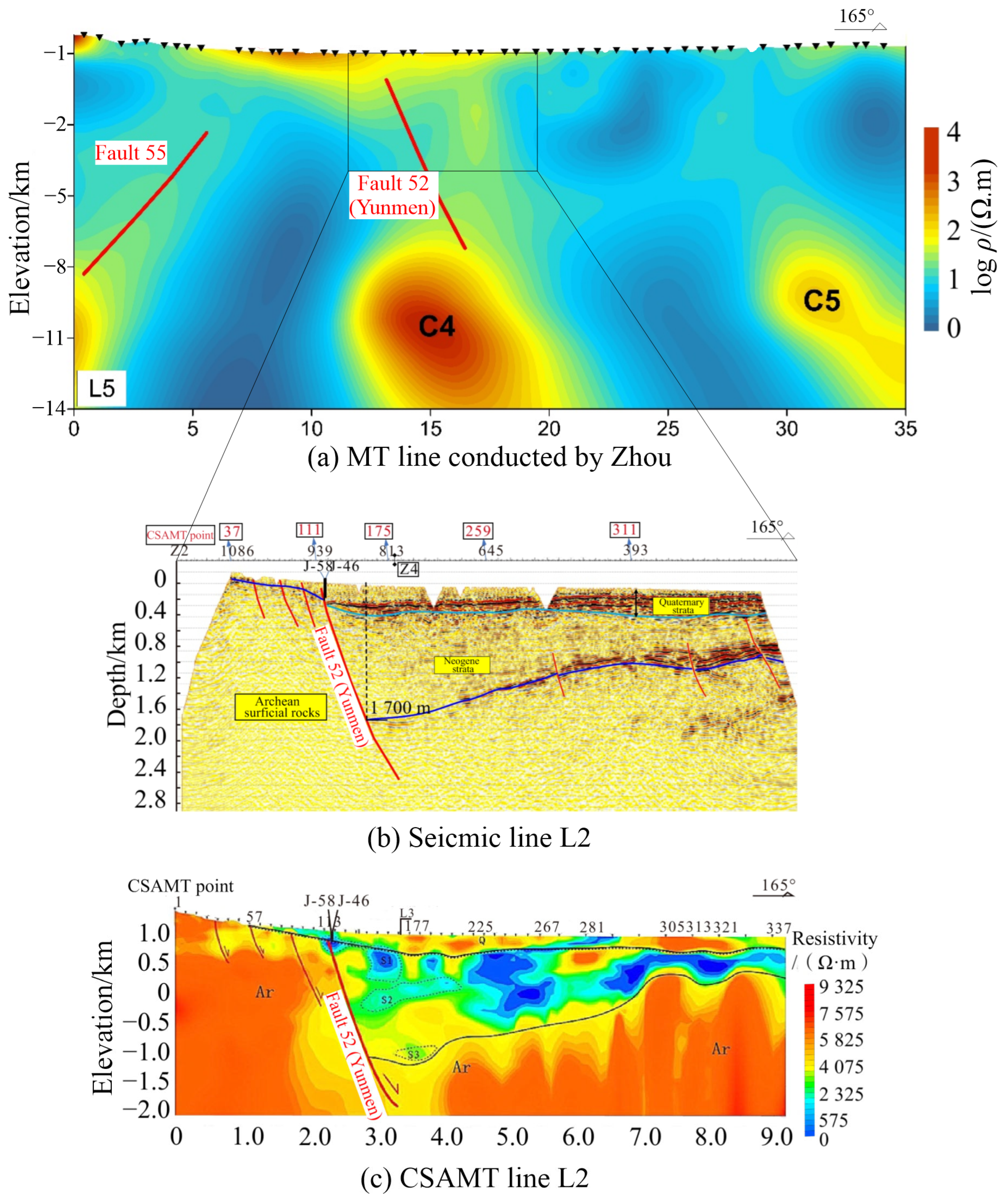
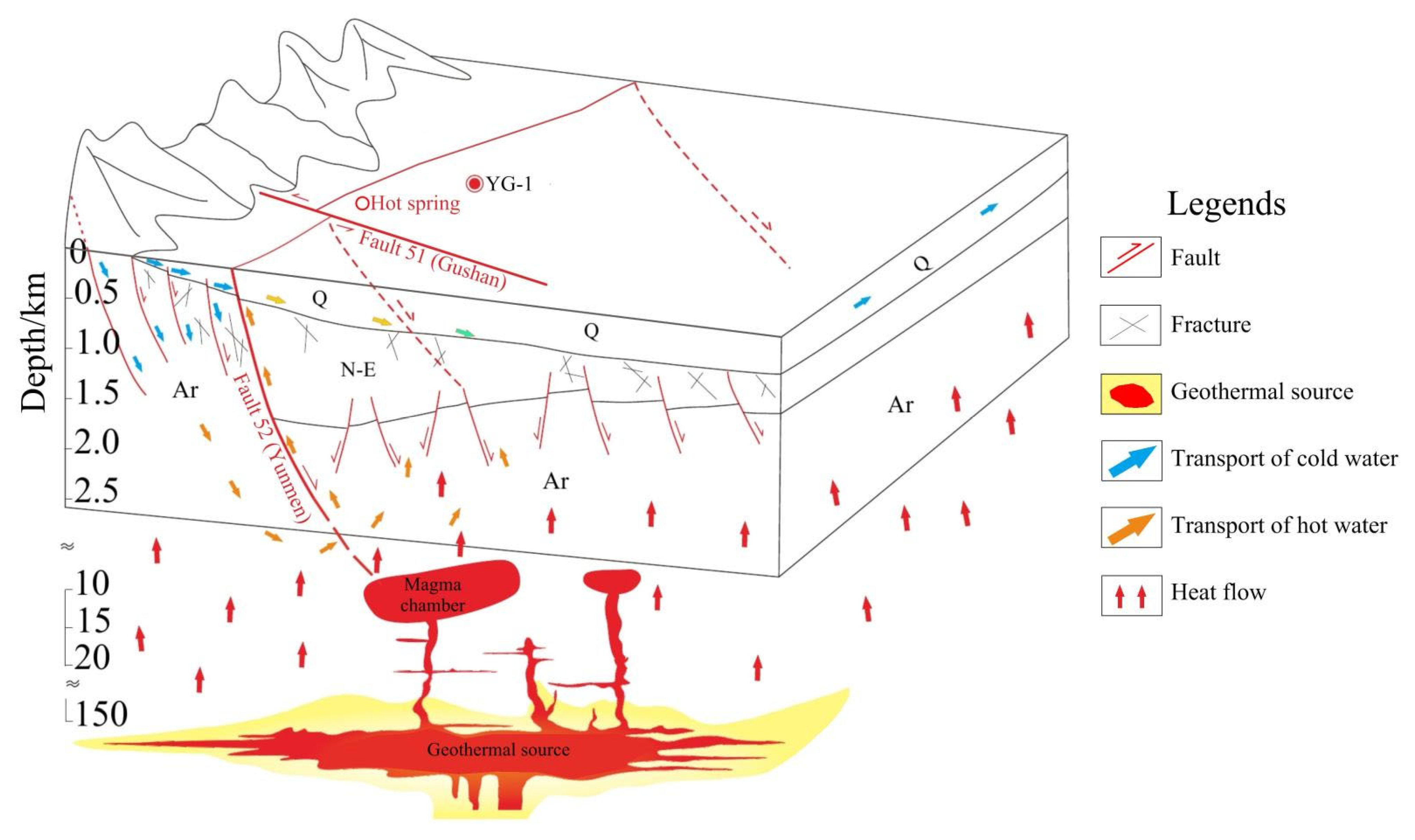
Disclaimer/Publisher’s Note: The statements, opinions and data contained in all publications are solely those of the individual author(s) and contributor(s) and not of MDPI and/or the editor(s). MDPI and/or the editor(s) disclaim responsibility for any injury to people or property resulting from any ideas, methods, instructions or products referred to in the content. |
© 2025 by the authors. Licensee MDPI, Basel, Switzerland. This article is an open access article distributed under the terms and conditions of the Creative Commons Attribution (CC BY) license (https://creativecommons.org/licenses/by/4.0/).
Share and Cite
Lu, Z.; Yang, Y.; Mo, Y.; Liao, H.; Cai, Y. Investigation and Evaluation of Geothermal Resources in Northern Shanxi Province, China. Energies 2025, 18, 1494. https://doi.org/10.3390/en18061494
Lu Z, Yang Y, Mo Y, Liao H, Cai Y. Investigation and Evaluation of Geothermal Resources in Northern Shanxi Province, China. Energies. 2025; 18(6):1494. https://doi.org/10.3390/en18061494
Chicago/Turabian StyleLu, Zhongxu, Yang Yang, Yajun Mo, Haizhi Liao, and Youlian Cai. 2025. "Investigation and Evaluation of Geothermal Resources in Northern Shanxi Province, China" Energies 18, no. 6: 1494. https://doi.org/10.3390/en18061494
APA StyleLu, Z., Yang, Y., Mo, Y., Liao, H., & Cai, Y. (2025). Investigation and Evaluation of Geothermal Resources in Northern Shanxi Province, China. Energies, 18(6), 1494. https://doi.org/10.3390/en18061494





